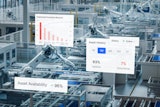A quality ERP system or data collection system can have a significant effect on a food manufacturer’s overall operational efficiency. Manufacturing Business Technology recently spoke with Reddy Beeram, Director Development, for Edgewater Fullscope about how these systems can affect traceability, inventory visibility, and other aspects of a food manufacturing enterprise.
MBT: What steps have food manufacturers taken to achieve success in the areas of traceability and data collection?
Beeram: One of the biggest investments for food manufacturers has been data collection systems that ensure that the data is all interlinked. Eventually, when you need to resurface that information, it provides visibility to all that linked data.
When you receive the raw materials, you want to know where it is coming from, the country of origin, and the date it was originally produced. Monitoring that information through an ERP system is the initial part of it. After the material moves through the system, you want to keep the information on the material that is manufactured. When you have a recall, you can quickly go back to it and look where it came from and also know where it went. This will allow you to be able to quickly react to the situation.
So the steps food manufacturers have taken are as follows: implementing ERP systems that can maintain and manage all of that information, and beyond that implementing some data collection processes where you actually work with the data and make sure that the data is linked back to the information in the ERP system (as well as the processes).
MBT: You mentioned some benefits to that ERP implementation. For example, the ability to react in the event of a recall or look back and find the source of a particular problem. But what are some less-obvious benefits to the data collection processes?
Beeram: Usually people don’t implement the data collection systems in order to get better traceability. They do it to have a better handle on their inventory and have real-time visibility to what actually moves on the warehouse floor. A data collection system will actually reflect that information in real time. That is the primary driver for a good data collection system. Traceability happens to be a secondary gain from implementing that data collection system.
MBT: Obviously there is significant cost that comes with this technology. How are companies balancing that cost versus receiving some of the benefits you’ve mentioned? Are they finding the cost and complexity that comes along with these implementations are worth it?
Beeram: There are multiple reasons to implement a good ERP system. It would address a broad spectrum of issues related to efficiency on the operations side within a manufacturing setting. It can help with customer retention and satisfaction, as well as improving several processes in the supply chain. Return on investment is difficult to generalize. It depends on the size of the company and the nature of problems that they have.
The typical return on investment for a data collection system can be anywhere from six months to two years. That refers to a data collection system using barcode labeling. You can do data collection with either barcode labels or with an RFID-type implementation. RFID implementations typically add more cost because the RFID readers cost more. Those investments push the return on investment to somewhere between 18 months and three years.
MBT: What are some of the critical questions companies in the food industry asking themselves when looking at this technology?
Beeram: A lot depends on the back ends of the manufacturing systems that the company would use. Normally the biggest challenge for companies that implement multiple sub-systems within a manufacturing environment is the data is not properly linked.
One of the questions to ask is: Do you have these multiple systems you have to manually link together? If that’s the case, then it’s maybe time for you to take a look at potentially implementing a good ERP system.
The next question is: Do you have good visibility to your inventory throughout the day? Things happen on the floor. But is that being reflected?
MBT: What are some of the barriers of implementation? What holds companies back from investing in an ERP solution or data collection system?
Beeram: I see companies deliberate on and debate about an ERP implementation system rather than a data collection system – if they have the right requirements for it.
The complexities that go along with implementing an ERP system, which requires people not only do their regular work, but they have to dedicate additional time to help get that ERP system into place. This poses some resource headaches.
ERP systems are also expensive. It’s not like implementing Microsoft Office across the board or something like that. Usually the process begins with evaluating multiple vendors that are a right fit for an organization. That fit has to be across the board. It’s not just manufacturing that would be affected. You have to consider whether it meets the requirements of the finance department, accounts-receivable requirements, accounts-payable requirements, product design requirements, and more. You have to bring all those departments in line and convince them to work with something new is definitely a difficult challenge once you cross the boundaries with capital requirements.


















